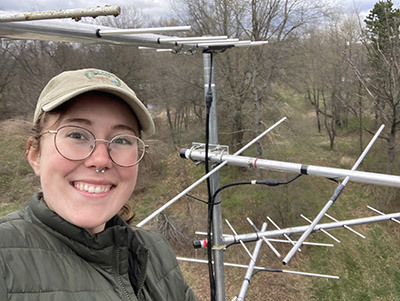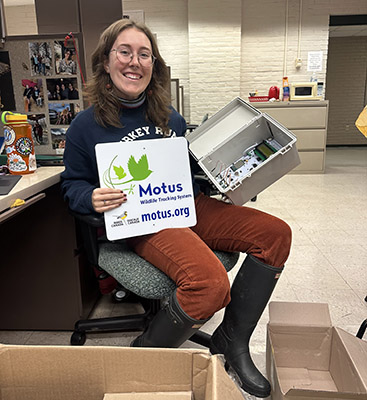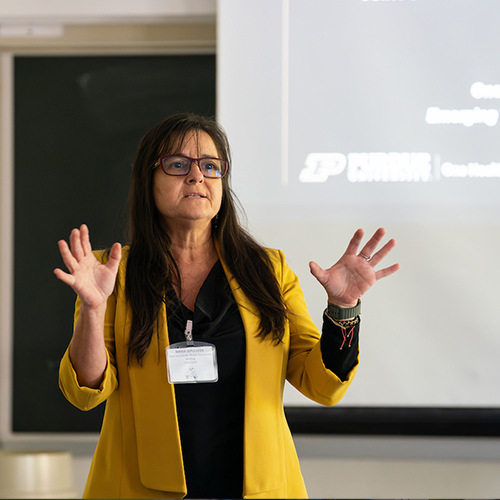Motus Towers Detect, Track Variety of Bird Species
Purdue Forestry and Natural Resources joined a nationwide research network in May when it put up Motus towers at the Purdue Wildlife Area, Richard G. Lugar Forestry Farm and Cunningham Woods.
towers at the Purdue Wildlife Area, Richard G. Lugar Forestry Farm and Cunningham Woods.
The towers, which pick up the signature of radio transmitters on a variety of wildlife species as they travel through the area, have been buzzing with activity in recent weeks.
Beginning in October, the towers picked up their first detections of birds from across the country and even from Canada. Here’s a quick look at some of the species that have been detected.
- Red-eyed Vireo (Vireo olivaceus)
- Purdue Motus Tower Location: Cunningham Woods
- Departed from: Western University, Ontario, Canada
- Yellow Warbler (Setophaga petechia)
- Purdue Motus Tower Location(s): Purdue Wildlife Area, Lugar Farm
- Departed from: Montreal, Canada
- Eastern Whip-poor-will (Antromus vociferus)
- Purdue Motus Tower Location(s): Purdue Wildlife Area, Lugar Farm
- Departed from: Ontario, Canada
- Common Nighthawk (Chordeiles minor)
- Purdue Motus Tower Location: Lugar Farm
- Departed from: MPG Ranch, Montana, U.S.
- Swainson's Thrush (Catharus ustulatus)
- Purdue Motus Tower Location: Lugar Farm, Cunningham Woods, Purdue Wildlife Area
- Departed from: British Columbia, Canada; Saskatchewan, Canada
 Images of a Yellow Warbler, a Red-eyed Vireo and an Eastern Whip-poor-will. Warbler and vireo images by Kaitlyn Young. Whip-poor-will photo courtesy of Dr. Lina Rifai, IU Kokomo.
Images of a Yellow Warbler, a Red-eyed Vireo and an Eastern Whip-poor-will. Warbler and vireo images by Kaitlyn Young. Whip-poor-will photo courtesy of Dr. Lina Rifai, IU Kokomo. Other species that have been detected by the three Purdue towers thus far are Wood Thrush (Hylocichla mustelina), Eastern Towhee (red eyed form – Pipilo erythrophthalmus/canaster), Blue-Winged Teal (Spatula discors) and Northern Saw-whet Owl (Aegolius acadicus).
A full look at the species that have been detected at each tower is available by clicking the location links above. Towers detect the location of any animal marked with radio-based transmitters that travels within a nine-mile radius of the tower.
The three towers near the Purdue campus are among the 21 MOTUS tower locations across Indiana, including one at the Purdue Southeastern Agricultural Center.
Dr. Barny Dunning explained being a part of the Motus tower network could have a local impact on Purdue students, in addition to assisting researchers across the world with animal tracking.
students, in addition to assisting researchers across the world with animal tracking.
“With the establishment of Motus towers at Purdue, existing class projects using radio transmitters will be enhanced,” Dunning said. “We also envision that students will be inspired to start new research initiatives, a core piece of the transformative experience we want to provide in FNR.”
Kaitlyn Young, a master’s student in Dunning’s lab, is utilizing the information from the towers for her research on eastern towhee migration in central Indiana.
“The Motus network made my master's project possible,” Young said. “My original research question was to determine when Eastern Towhees depart for fall migration. After attaching Cellular Tracking Technologies PowerTags on my sample of towhees, however, all the birds left their territory earlier than expected. Thanks to the Motus towers we installed at Purdue properties, I have some puzzling yet interesting results to report. Working with Motus has inspired so many more migration-related questions that I hope to explore as I continue my research career.”
The addition of the Motus towers at Purdue were made possible by funding from a grant program from the Purdue Office of Experiential Education, the Purdue Ag Alumni Trust Fund and the Mary Rice Grant program. The addition of the towers would not have possible without Brian Beheler of FNR and Joel Wahlman of SEPAC, who set the towers up at each location.
For more about the Motus network, visit their website.






